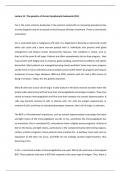Lecture 11. The genetics of chronic lymphocytic leukaemia (CLL)
CLL is the most common leukaemia in the western world with an increasing prevalence due
to early diagnosis and an increased survival because of better treatment. There is some family
association.
CLL is associated with a malignancy of B cells. It is diagnosed in blood by an abnormal raised
white cell count and a bone marrow packed with it. Individuals also present with gland
enlargement and biopsy reveals characteristic features. This condition is clonal, such as
they’re all the same B cell types. Patients are often asymptomatic but as they progress, they
may present with fatigue due to anaemia, gland swelling, autoimmune problems and spleen
discomfort. Most patients are managed by being closely watched. Some may never progress
and be more at risk on infections and secondary cancers while others do progress and require
treatment at some stage. Between 1989 and 1995, patients with CLL had a 50% chance of
dying in 10 years. Today, this has greatly improved.
Many B cells have a clear cell of origin. B cells mature in the bone marrow and later enter the
lymph nodes where they will fine tune their immunoglobulin and antigen receptor. They class
switch to mature immunoglobulin and fine tune their receptor via somatic hypermutation. B
cells may become memory B cells or plasma cells. CLL cells are antigen experienced, or
memory B cells, and have an activated phenotype; however, their cell of origin is unknown.
The BCR is of fundamental importance, such as somatic hypermutation rearranges the heavy
and light chains of the immunoglobulin via AID. In CLL, sometimes the immunoglobulin has
no mutations, this is unmutated CLL and patients have a slightly worse prognosis. Activity of
AID on the heavy and light chains, particularly in the complementarity determining regions,
confers a better prognosis; these patients have mutated CLL. A pathway must exist such as
exposition of AID does not occur, and BCRs do not undergo somatic hypermutation, thus
becoming U-CLL.
In CLL, a restricted number of immunoglobulins are used. 30% of all cases have a stereotyped
BCR. These patients may have a BCR that respond to the same type of antigen. Thus, there is
, an antigen-drive in CLL. Unmutated receptors that react in a poly-reactive way to antigen
signal more than those with mutated receptors that only respond to one antigen. This
increased signalling probably drives the cell more. The U-CLL B cell is thus more likely to
proliferate and stay alive. This is why U-CLL which responds more, signals more, lives longer
and divides more becomes more problematic than M-CLL. Damle et al. (1999) showed that U-
CLL BCRs are more likely to progress and have a lower survival compared to M-CLL BCRs
To diagnose CLL, conventional cytogenetics is used to look at gross changed. Fluorescent in
situ hybridisation allows to look at loss or gain of function of fusion genes. SNP arrays allow
to look for copy number variants. Gross genetic changes in CLL influence prognosis. Loss of
13q, gain of chr 12, loss of 11q and loss of 17p give us a clue of the underlying genomics of
the disease. Loss of 13q is a loss of a minimally deleted region with the enzyme BCL2,
important in apoptosis. Deletion of 17p is a loss of TP53, 80% of cases also carry a mutation
in the remaining allele. Deletion of 11q may be linked to ATM gene involved in genomic repair.
NOTCH1 association is present in trisomy 12 cases.
Deletion of 13q14 is present in more than 50% of cases. It is a loss of microRNAs, modulators
of translation of BCL2 gene. There also is influence on the NFkB gene. This 13q loss causes CLL
cells to be resistant to apoptosis, allowing them to live longer. TP53 and ATM gene are
involved in the cell cycle and DNA damage response. TP53 deletions or mutations are found
in 10% of cases, thus cells carry on living and confers resistance to chemotherapy. The 11q
deletion with a loss of ATM results in an aberrant DNA damage response, with cells being less
sensitive to chemotherapy. NOTCH1 is involved in cell proliferation and apoptosis. It is
associated with a gain of chromosomes 12. These patients are likely to develop a high grade
transformation of the disease.
NGS study found that CLL is more genomically complex than AML but most solid cancers and
DLBL are more complex. Whole exome sequencing found that there were no particular gene
resulting in defining this disease. However, SF3B1 recurrent mutations in CLL are involved in
RNA processing this is aberrant in this disease. The BIRC3 gene normally regulates anti-
apoptotic NFkB transcription factors and is involved in inflammatory pathways.




